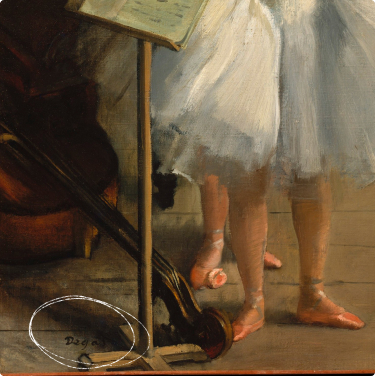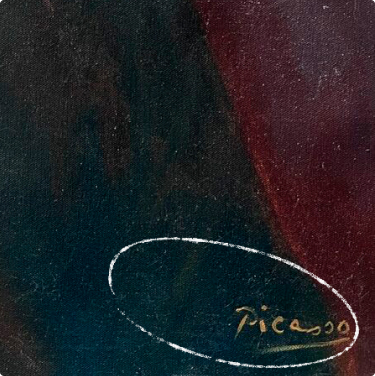Step by step: how to sign a painting correctly and create your own unique style
Newcomers in art often feel uncertain when it comes to signing their paintings. Sometimes they are too shy, and other times, they approach the process so meticulously that the signature becomes the focal point, overshadowing the artwork itself.
The question arises: what is the right way to proceed? Should you even sign your painting, and if so, how should you do it properly?
If the artwork is intended as a gift, the artist’s signature will add an extra pleasant surprise.
And in the case of publishing works online, the signature will serve as a guarantee that dishonest people will find it difficult to claim authorship of the painting.
Signature of the painting: Latin or Cyrillic
Art has always been a way to convey the artist’s feelings, thoughts, and emotions. However, when it comes to signing a painting, we begin to wonder: should we use Latin or Cyrillic script for the signature? This question is not only relevant in the context of the artist’s personal style but also raises interest in cultural and linguistic aspects.

Latin Script: The Global Language of Art
Contemporary art significantly interacts with the global community, and Latin script, being widely used in the digital space and international communication, is perceived as a universal language.
Latin letters in a painting’s signature serve as a bridge between the artist and viewers from different countries.
Cyrillic Script: Reflecting Cultural Context
On the other hand, Cyrillic script in a signature can highlight uniqueness, national identity, and historical roots. Cyrillic adds an extra layer of meaning to the artwork and engages the viewer through the lens of cultural heritage.
In the era of globalization and cultural exchange, many artists prefer to experiment with hybrid forms of signatures. Such signatures can combine Latin and Cyrillic characters, creating a unique code that blends cultural influences.
Ultimately, the choice between Latin and Cyrillic in a painting’s signature is a matter of the artist’s personal style and preferences.
This decision can be driven by aesthetic, cultural, and even emotional considerations. The signature becomes an integral part of the artwork, embodying not only the artist’s name but also their worldview.
Latin or Cyrillic: the choice is yours!
Signature of the painting: on the front and back
The signature on the front side of the picture is perhaps the first thing that catches the viewer’s eye. Name and date – these are the elements that create the history of a work and establish a connection between the creator and his creation.


- On the front side, we place a small signature — a delicate combination of the surname and initials — just like in a passport.
Often, the signature on the front side carries not only information about the artist but also certain meanings. For example, artists may embed symbols or small drawings in their signatures that reveal additional aspects of their creative concept.
However, this signature should be small enough not to distract from the main focus — the artwork itself.
- On the back side, you can provide a detailed explanation.
The signature on the back can include additional comments from the artist, dates of changes, and stages of creation. It also serves as protection against forgery, as a signature on the back of the painting is harder to copy than one on the front.
- Next to the front signature, include the year of creation.
This step will ease the work for exhibition organizers, art enthusiasts, and reduce time spent on document submissions for exhibitions, as well as when recovering personal creative and biographical information. Take care of the future in advance by marking the year with four digits, not just two.
- Typically, the artistic signature decorates the lower right corner of the painting, though there are unique exceptions to this rule.
If placing the signature in the lower right corner attracts too much attention, the artist may move it to another location. Sometimes such changes are done creatively; for example, Édouard Manet stood out by placing his signature on a wine bottle in his painting “Bar at the Folies-Bergère.” Examine this painting closely, and you will surely notice this unusual detail.
- You can create a unique logo or design symbol, similar to what Albrecht Dürer did.
Such a mark will become a personal element, giving your work a special status. A beautiful graphic element will highlight your skill and sophistication, down to the smallest details.
- The artist’s signature can be presented both in the native language (in this context, Russian/Ukrainian) and in Latin script.
The choice is up to the artist. It is important that the signature is legible and clear, regardless of the language.
- The color of the signature should contrast with the background.
The signature should not stand out from the overall color palette of the painting, as otherwise, your name will attract more attention than the depicted objects and subjects on the canvas, which is incorrect.
- It is recommended to use the same signature on all your artworks.
This will make it easier to recognize you among many other creators. Let your signature be clear and unequivocal — as a true reflection of your creativity. Remember that authorship is your key to success and protection against plagiarism.
By examining both the front and back of the painting, we can uncover new aspects of the artist’s creativity and better understand their inner world.
So, next time you pick up a painting, pay attention not only to the image but also to the mysterious traces left by the artist on their masterpiece. Who knows what they might reveal to you?
Rules and content of the signature on the painting


- A signature on a painting is a kind of personal imprint of the artist. It can be clear and refined, or bold and expressive. Such details reveal the artist’s character, style, and emotions.
- The artist should follow certain rules to ensure the signature does not overshadow the beauty of the work. Balance and harmony are important: the signature should not be too large and dominant, but it should not be lost against the background of the canvas either.
- Some artists embed a mystery or symbol into their signature, making it part of the story. By uncovering this mystery, the viewer expands their perception of the artist’s work.
- A signature on a painting also tells a story. It captures a moment in time, emotions, and circumstances surrounding the creation of the work. Like a diary, it becomes a testament to the artistic journey and inner world of the creator.
- The signature should be clear and easily readable. It should not conflict with the elements of the painting. This is why choosing the right font, size, and style is crucial in this process.
- The artist should sign their work with their real name or artistic pseudonym.
- Surround the signature with a date or an event related to the creation of the painting to capture it in history.
- The signature is often placed in the corner of the canvas but can also be integrated into the subject. It is important not to disrupt the overall composition of the work.
- Do not forget to add the creation date to the signature. This will give the work historical context and help track your development as an artist.
- The color of the signature letters should be contrasting, but overall, it should not clash with the general color scheme of the painting.

The content of a signature is an art in itself. It is the moment when an artist reveals their soul, giving the viewer a key to understanding the artist’s essence. It is gratifying to leave your signature on a painting and know that its creator is you! Let others know about it too.
Other artists constantly change the style of their signatures depending on the period of their creative work. This demonstrates their professional evolution and development of their artistic style, and sometimes it is simply a personal whim of the creator.
Electronic digital signature of the artist on the painting
Art has always been a realm where traditions intersect with new technologies. With the development of the digital age, many artists have moved beyond canvases and brushes to create their works using computer programs, graphic tablets, and other electronic devices. Along with this, a new concept has emerged — the electronic digital signature.
An electronic digital signature is often represented as a small, inconspicuous code embedded in the image file. Once the user opens the artwork on their device, they can point their camera at the work and view the artist’s hidden signature through an app. This signature reveals everything about the creator: their name, biography, links to other works, and provides interactive features — comments or the ability to ask the artist questions.
While this is very exciting and useful, it still sparks debates within the creative community. Some people believe that the artist’s signature should be the only comment left by the author, and everything else is a distortion of the original idea. Others see these opportunities as new horizons for creating and interacting with art.

Indeed, it is hard to say who is right here: the traditionalists or the proponents of technology? Perhaps the answer lies in the harmonious integration of both approaches, where the electronic digital signature becomes one of many tools used by artists to create and present their works.
But regardless of the outcome of this contentious discussion, new forms of signatures are a testament to the fact that art will always keep pace with the times and reflect the challenges of the contemporary era.
Truth is born in good dialogue!
Interesting signatures of famous artists
In past eras, artists, especially those who worked for the church, preferred not to sign their works. This was considered a sign of pride, while humility and anonymity were seen as virtues. How much has changed since those times…
For artists, the idea that fame could lead to additional earnings was irrelevant, as commissions came from the guild’s senior members. Even the great Michelangelo faced a curious situation. His sculpture group “Pietà” was attributed to another author, and the great sculptor had to carve his signature into the belt of the Virgin Mary (another important reason to sign your paintings!)
Still, renowned artists preferred to playfully and uniquely interpret their signatures. Vincent van Gogh was famous not only for his starry nights but also for his unusual signature on his paintings. His initials “VG” in the form of a swirl resemble the finishing touch of the artist’s brush, like the sun at the center of the universe.
Salvador Dalí, the great surrealist master, continued his eccentric style even in his signature. His signature consisted of intersecting letters, creating the impression of distorted reality, so characteristic of his works.
The founder of Impressionism, Claude Monet, left a signature that seems weightless and exhilarating, like a gentle spring breeze. His cursive letters evoke a sense of movement and freedom.
Pablo Picasso’s signature resembles a graphic representation of a face, with curved lines; it is almost a work of art in itself. In this way, the artist emphasized that art is something infinitely subjective and individual.
The modest Edgar Degas had his surname barely noticeable—he wrote it in the very corner of the canvas, while Paul Gauguin loved to sign his paintings with flair.
Each signature of a great artist is not just a combination of letters but a kind of metaphor reflecting the character, style, and approach to art of the artist. They, like the artworks themselves, leave us a legacy and inspire thoughts about the endless possibilities of creativity.


Finally
Initials carefully inscribed on the lower edge of the canvas represent more than just the identification of the artwork’s author. They are, rather, a kind of magic embedded in the signature—a key to a door of mystery, opening up to the viewer a world of creative inspiration.
When an artist signs their name on a painting, they are not only imparting a piece of their soul but also an incredible story told through colors and forms.
The signature on a painting is like a parental kiss left on the forehead of each piece. The signature is the creator’s business card, a reminder of their presence in every inch of the canvas.
Each signature is an act of courage, with which the author presents their work to the eternal archive of art. It is perhaps the most personal and honest gift an artist can give to the world—signing their soul, their dream, their story. For the signature contains not only the conclusion of the creative process but also the beginning of a deep dialogue between the artwork and those who are ready to listen.
Question-answer
The artist’s signature captures a moment of creative inspiration, allowing us to delve into the history of the artwork’s creation and learn more about its creator.
Like a fingerprint, the signature on a painting remarkably conveys the subtle nuances of the artist’s character, mood, and individuality. However, alongside its aesthetic significance, the artist’s signature also plays a practical role.
- Information: the artist’s signature on a painting provides us with information about the creator. This is useful for art historians, collectors, and enthusiasts who want to know who created the work.
- Significance: the signature can hold symbolic meaning for the artist. It acts as a sort of autograph, confirming their authorship and stamping their creative essence onto the piece.
- Protection against forgery: the artist’s mark on a painting can help prevent forgery. If a painting is signed by the artist, it means they consider it their intellectual property. The signature serves as important evidence in disputes over the authenticity of the work.
- Recognition: the creator may use a specific style or font to emphasize their authorship.
- Aesthetic value: the signature is also an important part of the design and composition of the work, adding its own charm. It can be simple and elegant or an integral part of the artwork’s decorative elements.
The signature not only carries informational value but also holds symbolic, functional, and aesthetic significance.
- Readability: Placing the signature in the bottom right corner allows viewers to easily find information about the artist without distracting from the study of the painting itself.
- Corner as a Frame: The bottom right corner serves as a natural conclusion to the composition of the painting. A signature in this spot creates a sense of completion and balance.
- Historical Legacy: In ancient times, a signature was essential for identifying the author and honoring the artist.
- Influence of Academic Art: During the development of academic art in Europe, with its strict system of norms and rules, placing the signature in the bottom right corner became a common and standard means of identifying the artist.
- Historical Context: Many great artists of the past, such as Leonardo da Vinci, Raphael, and Vincent van Gogh, signed their paintings in the bottom right corner. This fact may have influenced the establishment of this tradition.
- Holographic Signature: Use special inks or paints to write your name and signature in a holographic style.
- Illustration as a Signature: Faces, objects, or abstract elements can be represented as part of your signature. For example, if your signature consists of the initials of your first and last names, try creating an illustration where these letters become an actual part of the image.
- Use of Non-Traditional Materials: Instead of standard inks and paints, you can use other materials. Try signing your name with silk, special markers, or pearlescent paints.
- Creating a 3D Effect: Apply 3D modeling techniques to give your signature a three-dimensional appearance on the surface of the painting.
- Invisible Signature: You might like a signature that is visible only under certain lighting conditions or from specific angles. For this type of signature, you’ll need reflective materials or special paints to make it hidden and a bit mysterious.
- Personal Message: Write a heartfelt message related to the painting. It could be something like: “To the brightest person in my life, may every color remind you of my love.”
- Integration into the Artwork: Try incorporating the signature into the painting itself, making it part of the composition. Such a signature won’t be very visible to outsiders but will be meaningful to the recipient of the gift.
- Mystery: Sign the painting in the form of a riddle that the recipient has to solve. Add an element of intrigue and surprise.
- Quote: If you have a favorite quote related to the painting or that might inspire the recipient, include it in your signature.
- Secret Message: Include something personal that will be understood only by you and the future owner of the painting.
- Sign the painting with your name or pseudonym.
- Use a calligraphic approach to your signature, transforming it into a refined art. Elegant curves and transitions in the font will give your name or pseudonym a unique character.
- Create a shadow effect for your signature, as if it is floating above the surface of the painting.
- Integrate your name or initials into the details of the painting. Let the signature become part of the surrounding world of the artwork and reveal itself only upon close examination.
- Choose a color for the signature that harmonizes with the overall palette of the painting.
- Add a graphic element related to your style or the theme of the painting to your signature. This could be something abstract or stylized.
- Include a short quote in your signature that reflects the meaning of your work.




